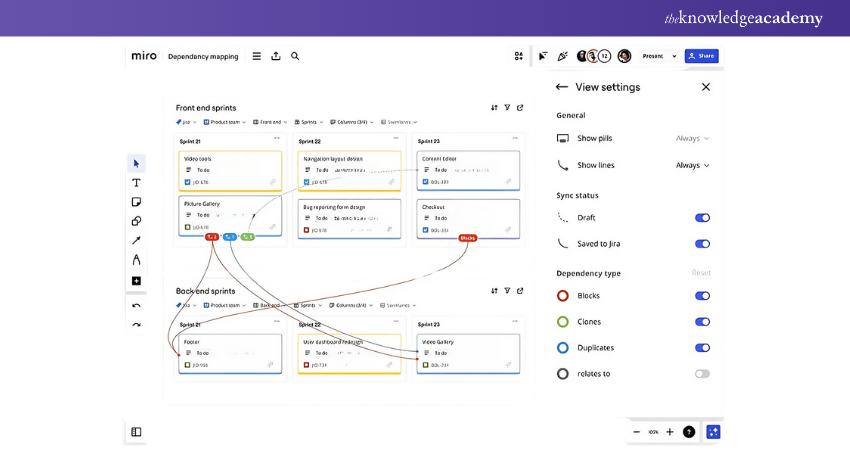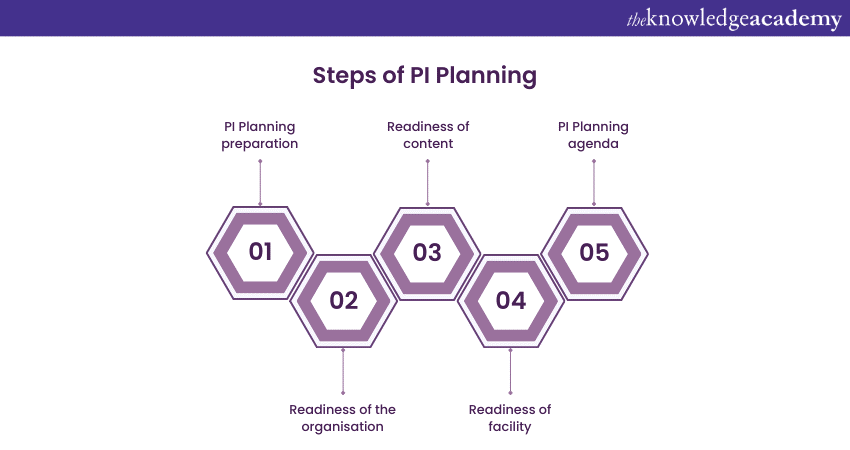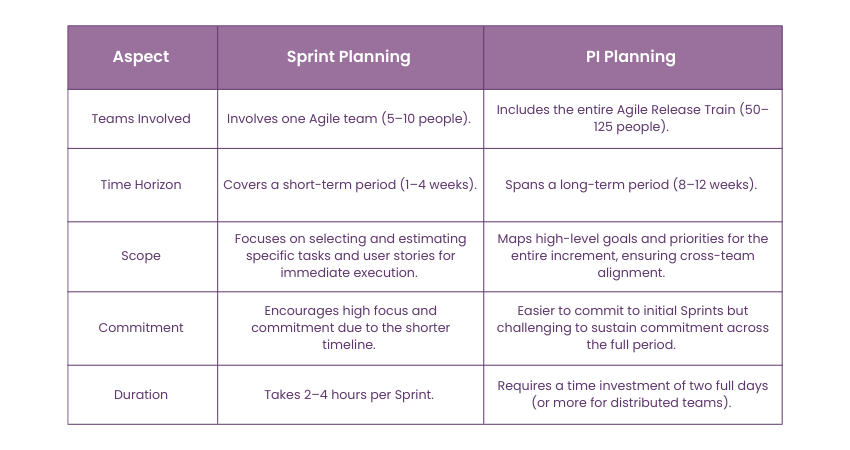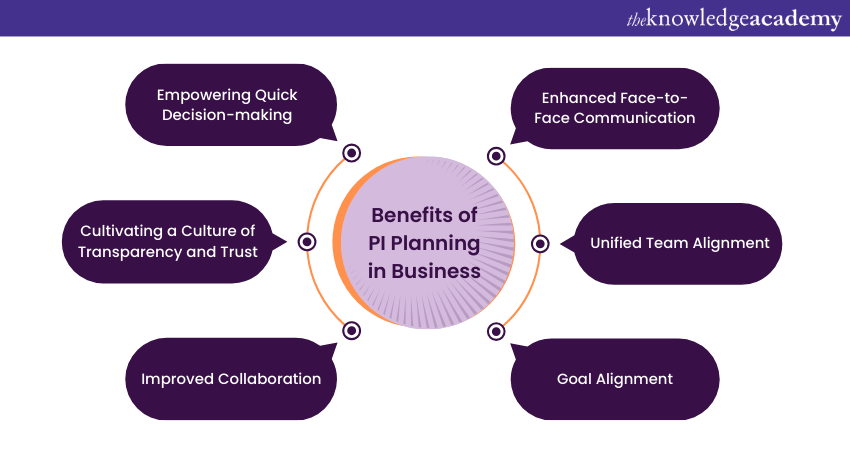We may not have the course you’re looking for. If you enquire or give us a call on 01344203999 and speak to our training experts, we may still be able to help with your training requirements.
We ensure quality, budget-alignment, and timely delivery by our expert instructors.

Imagine a team, each member with a vital role, crowded around a table, all working toward a single project's success. This is the heart of PI Planning, a cornerstone in Agile development. It's where success begins, where the plan for the program increment takes shape, and where teams unite for a shared mission.
Traditionally, many software development methodologies have been structured around the Plan-Do-Check-Act (PDCA) model, with a strong emphasis on the phases of planning, execution, inspection, and adaptation. In this blog, we'll uncover PI Planning in Agile Methodologies and learn about the process, benefits, and common challenges of PI Planning.
Table of Contents
1) What is PI Planning?
2) Importance of PI Planning
3) Goals Behind PI Planning
4) Steps of PI Planning
5) PI Planning vs. Sprint Planning
6) Benefits of PI Planning in Business
7) Common Challenges and How to Overcome Them
8) What is Capacity in PI Planning?
9) Who Communicates the Vision During PI Planning?
10) Conclusion
What is PI Planning?
Program Increment (PI) Planning is a cornerstone event in the Scaled Agile Framework (SAFe) that brings together Agile teams, business stakeholders, and project leaders for a collaborative planning session. Over one to two days, participants review the program backlog, set priorities, align on goals, and address dependencies to shape the roadmap for the upcoming increment.

While PI Planning focuses on short-term objectives, it aligns seamlessly with broader strategies, such as Agile quarterly planning, which targets long-term organisational goals. This session is also crucial for establishing the Agile Release Train (ART), a cohesive structure where multiple Agile teams work in sync toward shared objectives.
Importance of PI Planning
PI Planning stands as an invaluable asset for large-scale agile organisations. It offers transformative benefits that are particularly important if we consider the magnitude of these operations. To truly grasp the impact, it's worth delving into the numbers.
Picture this scenario: some of these mammoth organisations may comprise a staggering 200-300 teams and an army of 10,000 developers. In the traditional way of doing things, these teams often operated separately, hardly ever engaging in meaningful conversations unless a dire crisis necessitated it.
Historically, alignment efforts were primarily directed at the leadership team level, with multiple layers of management in between. This hierarchy might have conveyed information, but it rarely offers meaningful cross-team interactions. It created an endless struggle for resources, budget constraints, and coveted opportunities to work on high-visibility projects.
The concept of projects has often resulted in conflicting efforts. One team's release had the unfortunate tendency to disrupt the work of another team on a separate project, causing unintended clashes and setbacks. This is where PI Planning enters the stage as a transformative force. It serves as the catalyst, compelling these enterprises to bring their teams together—physically in the same room or virtually on the same call—to initiate long overdue conversations.
But why is this shift in approach so pivotal?
1) Systemic Impact: When working with a complex system or a shared code repository, understanding how changes affect other teams becomes important. The clarity provided by PI Planning ensures that teams can anticipate these impacts and adapt their approaches accordingly.
2) Interdependencies: In the complex web of interdependencies, teams often find themselves needing to perform preparatory work to enable other teams to proceed smoothly with their features. PI Planning lays the foundation for these mutual adjustments, allowing for seamless collaboration.
In essence, PI Planning introduces a fundamental shift in the dynamics of these organisations, showing in a new era of:
1) Communication: Teams that once worked in isolation now engage in meaningful conversations, promoting a culture of information exchange.
2) Visibility: The fog of obscurity lifts, and teams gain greater visibility into the activities of their counterparts, allowing them to plan more effectively.
3) Collaboration: Collaboration becomes the order of the day. As teams align and share their goals, they unlock the potential for greater collective achievements.
The outcomes are nothing short of remarkable. Teams operate with enhanced efficiency, delivering a multitude of features within compressed timeframes and, crucially, staying within budget constraints.
PI Planning emerges as a linchpin in the transformation of large-scale agile organisations, not merely as a tactical measure but as a catalyst for a profound shift in culture and practice.
Ready to ace your Agile interview? Dive into these essential Agile interview questions now!
Goals Behind PI Planning
PI Planning is a powerful tool that brings teams together to align on their goals. It's a fantastic opportunity for collaboration and trust-building. Here's how PI Planning can deliver real value:
1) Align Agile Teams
Cross-functional collaboration can be challenging, especially for distributed and remote teams. PI Planning helps everyone get on the same page. For instance, teams might use a SAFe program board during the session to visualise dependencies and track deliverables, making it clear how each role contributes to the larger mission.
2) Set Clear Goals
During PI Planning, teams break down high-level goals into specific, measurable targets. This helps ensure everyone understands what success entails. Planning tools such as Miro’s SMART Goals Template can be extremely useful for setting clear objectives.
3) Build Trust
The collaborative nature of PI Planning fosters open conversations. As team members share ideas and concerns, they strengthen relationships and build trust. Breakout sessions allow Agile teams to discuss challenges openly, creating a supportive environment.
4) Improve Customer Experience
When teams align their processes through PI Planning, customers benefit from a smoother experience. Teams can prioritise customer feedback and adjust their roadmaps accordingly, leading to more relevant and timely product updates.
5) Facilitate Quick Decision-Making
Bringing everyone together for PI Planning speeds up decision-making. Diverse perspectives help teams quickly identify solutions to challenges. If a team encounters a roadblock, they can brainstorm alternatives on the spot, making informed decisions without delay.
6) Prioritise Tasks
During PI Planning, teams identify and prioritise the most important tasks. Using techniques like the MoSCoW method, teams can focus on high-impact items, tackling the important work first to maximise productivity and drive value.
Steps of PI Planning
The steadfast rhythm of PI Planning, intricately aligned with the overarching release plan, ensures its seamless integration into the organisational calendar. This adherence to a pre-defined schedule offers multifaceted benefits—it effectively reduces the cost associated with directing these events while also enabling participants to proactively manage their other commitments, guaranteeing their presence and full engagement in these pivotal gatherings.
Now, let's navigate through the preparation stages leading up to the PI Planning ceremony, which is marked by a series of pre-event steps. These steps, along with a well-structured agenda for the central ceremony, are crafted to maximise the value derived from the extensive effort dedicated to aligning teams and stakeholders.

Step 1: PI Planning Preparation
The PI Planning ceremony is a well-rounded process involving pre- and post-event measures. These preparatory steps, including pre-defined roles and responsibilities, are vital in uniting team members, leadership, and stakeholders across the organisation. This sets the stage for evolving the backlog throughout the increment.
Step 2: Readiness of the Organisation
Strategic alignment among participants, stakeholders, and business/application owners is paramount. Achieving this alignment involves understanding the scope and context of planning, gaining agreement on business priorities, and ensuring that agile teams are in place with dedicated team members, scrum masters, and product owners for each team.
Step 3: Readiness of Content
This stage is a crucial requirement for a clear vision and context. Essential components encompass executive briefings, product vision briefings, and architecture vision briefings, all designed to provide a comprehensive understanding of the landscape.
Step 4: Readiness of the Facility
Creating a collaborative environment, whether virtual or physical, for distributed or co-located teams is vital. It necessitates investments in technical infrastructure and focuses on key criteria, including preparing locations, providing access to technology and tools, and ensuring robust communication channels, mainly through AV equipment and presentation tools.
Step 5: PI Planning Agenda
Each occurrence of a PI Planning event adheres to a consistent 2-day schedule, organised with activities thoughtfully distributed across these two days. This structured approach is pivotal in ensuring that the event remains faithful to its purpose and that the intended outcomes are realised as planned.
While the standard is set at a 2-day duration, there can be flexibility in the timeline, contingent upon the unique dynamics and configuration of each organisation and its teams. The specific requirements and complexities of the setup may influence the precise duration of the event.
Elevate your Agile project management skills with our Agile Project Management Practitioner (AgilePM®) Course – Sign up now and upgrade your expertise!
PI Planning vs. Sprint Planning
PI Planning and Sprint Planning are essential Agile events, but they serve different purposes. While Sprint Planning focuses on short-term goals for individual teams, PI Planning takes a broader approach, aligning multiple teams on long-term objectives.

1) Teams
Sprint Planning involves one Agile team (5–10 people), whereas PI Planning includes the entire Agile Release Train, bringing together 50–125 participants.
2) Time Horizon
Sprint Planning occurs every 1–4 weeks, focusing on immediate deliverables. PI Planning spans 8–12 weeks, aligning goals for the quarter. Organisations often choose 12 weeks to sync with financial quarters, while others opt for 8 weeks for more agility.
3) Scope
Sprint Planning narrows down the selection and estimation of specific tasks and user stories. PI Planning, however, maps out high-level goals and ensures cross-team alignment over the entire increment.
4) Commitment
Shorter Sprints foster focused commitment, while the longer horizon of PI Planning makes it easier to commit to initial Sprints but harder to sustain equal dedication throughout.
5) Duration
Sprint Planning typically lasts 2–4 hours, while PI Planning requires a more substantial time investment, often spanning two full days to coordinate larger teams and strategies.
Benefits of PI Planning in Business
PI Planning brings a multitude of compelling business advantages, including:

1) Enhanced Face-to-face Communication: By facilitating direct, real-time conversations among team members, PI Planning promotes open and effective communication.
2) Unified Team Alignment: It serves as a powerful tool for aligning diverse teams into a cohesive and supportive model for the Agile Release Train (ART), fostering a sense of collective purpose.
3) Goal Alignment: PI Planning effectively aims for the organisational goals within the context of the business, vision, and Program Increment (PI) objectives, ensuring clarity and alignment.
4) Improved Collaboration: This event is instrumental in boosting collaboration, ultimately reducing work-in-progress (WIP) and wait times, thereby enhancing efficiency.
5) Cultivating a Culture of Transparency and Trust: PI Planning encourages a culture of transparency, trust, and team building, which are vital for harmonious and productive teamwork.
6) Empowering Quick Decision-making: It equips teams and stakeholders with the agility to make swift and well-informed decisions, promoting efficiency and adaptability.
Common Challenges and How to Overcome Them
The well-regarded Agile manifesto firmly advocates for the supremacy of face-to-face communication. Yet, the realities of today's globalised and geographically dispersed teams often challenge this ideal. In such instances, the virtual PI Planning sessions are tailored to accommodate distributed teams. Due to the interdependent nature of this event, it is important that all participants are not only present but fully engaged and attentive throughout the entirety of the event.
Still, PI Planning doesn't always go smoothly, especially the first time, and the framework itself can be challenging for some organisations. Here are some common mistakes and challenges to be aware of and try to avoid:
1) Long and Tedious Sessions: PI Planning often involves long and heavy sessions right from the beginning. Finding ways to make these sessions more engaging, delivering important business context information differently, or adjusting the schedule to make them shorter can be beneficial. This leaves more time for team planning and collaboration.
2) Technical Issues: Technical problems can affect any event, but when you're streaming audio and video to a distributed team, it can disrupt the flow of the event. Testing equipment and connections thoroughly before the event can help minimise potential issues.
3) Confidence Vote: Some participants may find the concept of a confidence vote challenging. They might feel pressured to vote in favour of a plan rather than voicing their concerns.
4) Time Constraints: When you have a large Agile Release Train (ART) with many teams, presenting and reviewing draft plans for all of them can be time-consuming. This can result in lower-quality feedback compared to smaller ARTs with fewer teams.
5) Commitment to the Process: SAFe and PI Planning aren't flawless, but they have been successful for many organisations. It's essential to follow the framework's recommendations and fully commit to the process.
6) Using Outdated Tools: If your current tools aren't working well, it's important to make changes. For instance, traditional SAFe Program Boards may not always be practical. If your post-it notes keep falling off, data in Jira doesn't seem right, or your distributed team needs a digital solution, consider upgrading to a digital program board like Easy Agile Programs.
Jumpstart your Agile journey today - Explore our Agile Project Management Foundation & Practitioner (AgilePM®) Course and pave the way for your project's success!
What is Capacity in PI Planning?
Capacity in PI Planning represents the ability of Agile teams to complete planned work during a Program Increment (PI). It accounts for factors such as team size, availability, holidays, and historical velocity. During PI Planning, teams assess their capacity to estimate how much work they can commit to within the PI timeline.
This assessment ensures realistic planning, prevents overloading, and aligns deliverables with available resources. By balancing workload and capacity, teams can maintain high-quality outputs, reduce risks of burnout, and ensure a sustainable pace throughout the increment. Proper capacity management is vital for successful execution and meeting organisational objectives.
Who Communicates the Vision During PI Planning?
The vision in PI Planning is typically communicated by the Product Manager or the Business Owner. These roles provide a strategic overview of the program’s goals, customer needs, and market priorities. The vision serves as a guiding light for all teams, ensuring alignment on the purpose behind the planned features and objectives.
During the session, the Product Manager explains how the program fits into the broader business goals and shares insights about customer expectations, competitive landscape, and anticipated value delivery. This clear communication promotes a shared understanding among teams, promotes collaboration, and inspires commitment to achieving the goals of the Program Increment.
Conclusion
PI Planning is like the foundation of a project when it comes to organisational activities. Although it might seem complex, especially with many people and viewpoints, it's all about teamwork. By understanding this method of Planning, teams can come together to tackle common challenges, deal with dependencies, and work concurrently to create the most efficient software solutions.
Architect your Agile success – Register now for our SAFe® For Architects Training and become a certified SAFe for Architects!
Frequently Asked Questions
Who is Involved in PI Planning?

PI Planning includes Agile teams, Product Owners, Scrum Masters, Business Owners, and stakeholders. They collaborate to align on the vision, set priorities, and define the objectives for the upcoming Program Increment. This ensures that everyone has clarity on goals, dependencies, and their role in delivering value.
How to Prepare for a PI Planning Session?

PI Planning includes Agile teams, Product Owners, Scrum Masters, Business Owners, and stakeholders. They collaborate to align on the vision, set priorities, and define the objectives for the upcoming Program Increment. This ensures that everyone has clarity on goals, dependencies, and their role in delivering value.
What are the Other Resources and Offers Provided by The Knowledge Academy?

The Knowledge Academy takes global learning to new heights, offering over 3,000 online courses across 490+ locations in 190+ countries. This expansive reach ensures accessibility and convenience for learners worldwide.
Alongside our diverse Online Course Catalogue, encompassing 19 major categories, we go the extra mile by providing a plethora of free educational Online Resources like News updates, Blogs, videos, webinars, and interview questions. Tailoring learning experiences further, professionals can maximise value with customisable Course Bundles of TKA.
What is The Knowledge Pass, and How Does it Work?

The Knowledge Academy’s Knowledge Pass, a prepaid voucher, adds another layer of flexibility, allowing course bookings over a 12-month period. Join us on a journey where education knows no bounds.
What are the Related Courses and Blogs Provided by The Knowledge Academy?

The Knowledge Academy offers various Agile Training, including Agile Project Management Foundation, Agile Project Management Practitioner and Agile Project Management Foundation & Practitioner. These courses cater to different skill levels, providing comprehensive insights into the Agile Roles and Responsibilities.
Our Project Management Blogs cover a range of topics related to Agile, offering valuable resources, best practices, and industry insights. Whether you are a beginner or looking to advance your Project Management skills, The Knowledge Academy's diverse courses and informative blogs have you covered.
Upcoming Project Management Resources Batches & Dates
Date
 AgilePM® Foundation & Practitioner (AgilePM® v2)
AgilePM® Foundation & Practitioner (AgilePM® v2)
Tue 22nd Apr 2025
Mon 28th Apr 2025
Tue 6th May 2025
Mon 12th May 2025
Sat 17th May 2025, Sun 18th May 2025
Mon 19th May 2025
Tue 27th May 2025
Mon 2nd Jun 2025
Mon 9th Jun 2025
Mon 16th Jun 2025
Mon 23rd Jun 2025
Mon 30th Jun 2025
Mon 7th Jul 2025
Mon 14th Jul 2025
Sat 19th Jul 2025, Sun 20th Jul 2025
Mon 21st Jul 2025
Mon 28th Jul 2025
Mon 4th Aug 2025
Mon 11th Aug 2025
Mon 18th Aug 2025
Mon 25th Aug 2025
Mon 1st Sep 2025
Mon 8th Sep 2025
Mon 15th Sep 2025
Sat 20th Sep 2025, Sun 21st Sep 2025
Mon 22nd Sep 2025
Mon 29th Sep 2025
Mon 6th Oct 2025
Mon 13th Oct 2025
Mon 20th Oct 2025
Mon 27th Oct 2025
Mon 3rd Nov 2025
Mon 10th Nov 2025
Sat 15th Nov 2025, Sun 16th Nov 2025
Mon 17th Nov 2025
Mon 24th Nov 2025
Mon 1st Dec 2025
Mon 8th Dec 2025
Mon 15th Dec 2025






 Top Rated Course
Top Rated Course



 If you wish to make any changes to your course, please
If you wish to make any changes to your course, please


